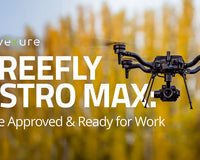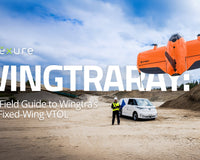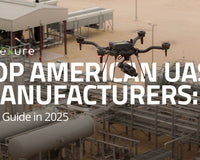Having hit the US market just weeks ago, DJI Dock 2 is redefining the standards of remote operations. Dock 2 boasts a design that is 68% lighter and 75% smaller than its predecessor, making it remarkably easy to transport and set up. Paired with the all-new Matrice 3D series drones, the Dock 2 ensures rapid deployment, faster charging, and robust operations even in challenging weather conditions, thanks to its IP55 weather resistance rating.
With these improvements, you may ask yourself: Should I invest in Dock 2? What does the setup, installation, and configuration entail? Are there specific regulatory requirements for remote operations? These are critical questions for any organization to consider.
In this article, we'll explore the types of industries that would benefit from Dock 2, budget considerations for operation and deployment, installation requirements, and regulatory requirements for remote operation.
Table of Contents
DJI Dock 2 Industry Use Cases
Budgeting and Costs
Location and Connectivity
Regulatory Considerations
In Conclusion
DJI Dock 2 Industry Use Cases
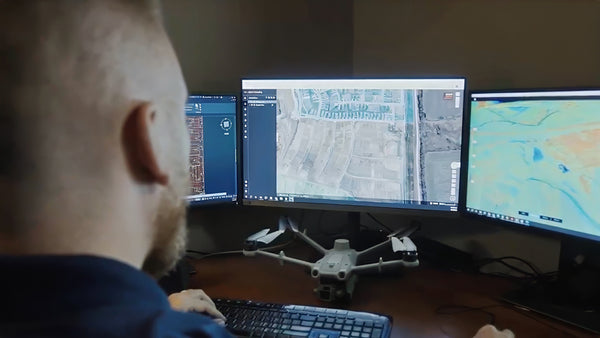
Drone as a First Responder (DFR)
In emergency response scenarios, where every second counts, Dock 2 changes how first responders use drones to enhance safety and efficiency. Drone-in-a-box solutions streamline operations by having a drone charged and standing by, ready to respond to emergency calls. A Matrice 3TD launched from Dock 2 can help provide real-time aerial insights that are critical during the initial stages of a call. Implementing DJI Dock 2 allows for a Matrice 3TD drone to be launched within seconds of receiving a 911 call, significantly reducing response times and improving outcomes. Drones are deployed rapidly and are ready to provide live streaming data to the responding units and command staff, increasing situational awareness without the delays of traditional drone response.
Strategically placed at high-activity locations, Dock 2 can leverage remote connectivity solutions like Starlink, Blu-Link, and Advexure’s hand-picked cellular mobility solutions to ensure uninterrupted operation, even in remote areas. Installation on rooftop sites such as police stations, fire stations or other tall city/county buildings allows drones to cover areas with high call volumes effectively.
Operational Benefits
The primary advantages of DJI Dock 2 in a DFR context include:
- Rapid Deployment: Dock 2 can be airborne in 45-60 seconds of a call, arriving on the scene much quicker than patrol units.
- Enhanced Situational Awareness: Live streaming capabilities allow first responders to assess the situation en route to the scene.
- BVLOS Operations: Enables operations beyond the visual line of sight, reducing personnel's need for direct visual supervision (this will require a waiver from the FAA).

Architecture, Engineering, and Construction (AEC)
In the Architecture, Engineering, and Construction (AEC) sector, DJI Dock 2 is proving instrumental in transforming traditional surveying and inspection processes, particularly in complex environments like large-scale material sites, significantly enhancing data accuracy, frequency, and safety in routine operations.
Dock 2 can help automate critical data collection tasks such as stockpile measurements and conveyor inspections. The system enables scheduled and on-demand drone flights without an onsite pilot, streamlining operations and ensuring high-frequency, consistent data collection. This type of automation is particularly beneficial for sites with complex operating environments and heavy vehicle traffic, where manual surveying processes can be less safe and inefficient.
DJI Dock 2 is typically installed in elevated positions, such as atop a construction trailer, or at the high point of a site, to cover areas effectively. This setup includes the Matrice 3D's advanced navigation and mapping capabilities, ensuring precise data collection. Using flight planning software like DJI FlightHub 2 for mapping and inspection missions allows these drones to capture detailed 3D models and conduct thorough inspections from safe distances. The DJI M3D aircraft’s 4/3” CMOS sensor with a mechanical shutter is every geospatial analyst's dream for producing high-resolution, distortion-free aerial images, essential for accurate mapping and 3D modeling in photogrammetry projects.
Operational Benefits
The primary benefits of DJI Dock 2 in AEC applications include:
- Enhanced Data Accuracy and Frequency: Regular automated flights ensure up-to-date and precise data for inventory management and compliance reporting.
- Increased Safety: Automating drone flights reduces the need for personnel to conduct manual surveys in potentially dangerous or inaccessible areas.
- Efficiency in Data Processing: Integration with third-party photogrammetry platforms allows for automatic data syncing and analysis, facilitating rapid decision-making.

Mining
In the mining industry, adopting DJI Dock 2 can enhance safety and improve operational efficiency. Traditional drone operations in mining often need help with data quality and require extensive human resources to operate drones.
Dock 2 automates routine and repetitive data capture, reducing the need for pilot presence onsite. This system facilitates remote monitoring from an off-site Remote Operating Center (ROC), allowing technical personnel to concentrate on data analysis and decision-making. For instance, Dock 2 can automate volumetric measurements of stockpiles and detailed geological assessments of pit walls.
Equipped with the Matrice 3D drone, DJI Dock 2 is set up with minimal infrastructure, featuring cooling systems for hot climates and robust connectivity options for reliable data transfer. Data captured is quickly processed and analyzed via cloud-based platforms, optimizing surveying and compliance tasks.
Operational Benefits
DJI Dock 2 offers substantial benefits in mining operations:
- Reliability and Consistency in Data Capture: Data capture is consistent in timing and quality, which is crucial for compliance and reporting in the mining sector.
- Increased Operational Efficiency: DJI Dock 2 helps mining operations streamline workflows and improve productivity by reducing the time involved in manual data capture and increasing the frequency of critical surveys.
- Safety and Compliance: Automating drone flights reduces the need for personnel to conduct potentially hazardous manual surveys, particularly in unstable or difficult-to-access areas of a mine.
- Resource Optimization: The ability to remotely operate drones reduces the need for technical personnel onsite, which is particularly beneficial for remote or fly-in-fly-out mining operations.
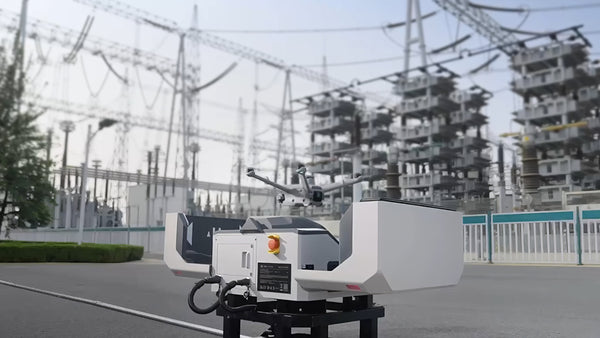
Energy and Utilities
DJI Dock 2 is already changing how utilities monitor and maintain their vast and diverse energy sector assets. From solar farms to high-voltage power lines, the integration of automated drone deployments is enhancing the efficiency and safety of infrastructure inspections.
Dock 2 can run daily automated patrols and on-demand asset inspections, significantly reducing the need for manual drone inspections. This allows energy companies to monitor asset health continuously, perform visual and thermal inspections, and update digital base maps more efficiently and at lower costs.
Deployed strategically across various energy production sites, Dock 2, via FlightHub 2, can execute complex missions, such as detailed inspections of solar panels and power lines. These missions are tailored to specific environmental conditions and operational requirements, including optimal weather settings for solar inspections and precise altitude settings for power line scans.
Operational Benefits
Key benefits of using DJI Dock 2 in the energy/utilities sector include:
- Reduced Inspection Costs: Automation lowers the frequency and need for costly manual inspections.
- Enhanced Safety: Reduces the risk to human inspectors by utilizing drones for high-risk inspection areas.
- Increased Inspection Efficiency: Faster data capture and processing speed up decision-making.
Additionally, for solar panel inspections, DJI Dock 2 can be programmed to conduct orthophoto mapping and thermal imaging to assess panel health, optimizing the time of day for maximum sunlight exposure. The system provides high-resolution images processed rapidly in the cloud, offering immediate insights into panel efficiency and highlighting areas needing attention.
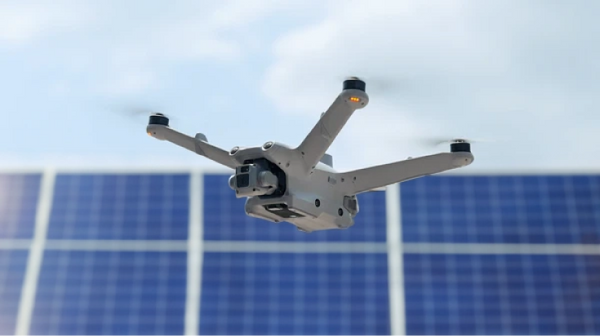
Dock 2 executes flight plans for high-voltage power line inspections that maintain a safe distance above the infrastructure, capturing detailed point clouds for structural analysis. These inspections help identify potential issues before they lead to failures, ensuring continuous power supply and system reliability.
Budgeting and Costs
Investing in DJI Dock 2 involves various financial considerations beyond the system's initial purchase price. Understanding the full spectrum of costs associated with deploying and operating a drone-in-a-box solution is crucial for potential investors and users. Here's a breakdown of key considerations:
Initial Purchase and Setup Costs
Purchase Price: The starting price for DJI Dock 2 packages is $14,699 with Matrice 3D and $16,569 with Matrice 3TD. This includes the Dock, aircraft, flight battery and DJI RC Pro Enterprise. Additional accessories such as spares, speakers, spotlights, etc are all sold separately.
Installation Costs: Although Dock 2 is designed for easy transport by a two-person team, installing it in locations like rooftops may require a crane, adding to the installation costs. Also keep in mind that depending on your specific location, you may have additional costs such as platforms, supports, levelers, fencing and other safety and security add-ons.
Operational Costs
Power Consumption: Dock 2 requires a continuous power supply, consuming up to 1,000 Watts with a steady operating voltage of 27 V DC. This constant power requirement can add to operational costs, particularly in 24/7 deployment scenarios where the Dock is always on and ready to launch at a moment’s notice.
Regulatory Costs
BVLOS Waivers: Deploying Dock 2 for Beyond Visual Line of Sight (BVLOS) operations might necessitate FAA waivers, which involve consulting with Advexure’s waiver team or other industry waiver consultants. The costs for these consultations can vary based on the complexity of the airspace and operational environment. Reach out to Advexure's team if you need help with BVLOS waivers.
COA for Public Safety: Public safety entities might also incur costs for obtaining Certificates of Waiver or Authorization, typically costing far less than BVLOS waivers, or sometimes even no cost by leveraging publicly available resources from organizations like DRONERESPONDERS.
Part 107 Certification: For operations adhering strictly to FAA Part 107, obtaining the necessary pilot certifications has a cost associated, although minimal, and will vary based on the course and testing preparation route you take.
Personnel & Training Costs
Remote Pilot in Command (RPIC): If entire BVLOS operations are not feasible, maintaining an RPIC onsite to ensure the drone remains within line of sight is necessary. If current staff are not qualified or available, this might require hiring external personnel.
Training Costs: Onsite training for staff and crew to operate the new system effectively is crucial and should be budgeted accordingly.
Maintenance and Miscellaneous Costs
Ongoing Maintenance: Regular maintenance includes replacing drone propellers and batteries, cleaning the Dock, and possibly replacing internal components such as the backup battery, HVAC fan, temperature sensor, etc. These costs will vary depending on usage frequency and operational conditions and environment. Overall, DJI Docks have been fairly maintenance free throughout their life cycle. Dock Maintenance and Repair Service is conducted nationwide by Advexure’s DJI Certified Dock Engineers and Technicians.
Shipping Costs: Depending on your ship to location and specific components involved in your remote operation deployment and installation, there may also be shipping costs when ordering from official Dock 2 dealers like Advexure.
Costs can vary significantly based on the specific industry, use case, and geographical location. For a tailored estimate that fits specific operational needs, consult with Advexure's Dock 2 solution specialists today.
Location and Connectivity
Choosing the optimal location and ensuring robust connectivity is pivotal for the successful deployment and operation of DJI Dock 2. This section outlines the critical considerations for site selection and connectivity requirements to maximize the efficiency and reliability of drone operations.
Site Selection Criteria
- Central to Operations: The installation site for Dock 2 should be strategically chosen to be central to one's operational area. This positioning ensures that drones can efficiently cover the intended area, minimizing travel time and maximizing flight efficiency.
- Accessibility for RPIC: If not operating under full Beyond Visual Line Of Sight (BVLOS) regulations, the location must be easily accessible for a Remote Pilot in Command (RPIC) who can maintain a line of sight with the drone. This accessibility is crucial for safety and compliance with aviation regulations.
- Power Supply: Dock 2 requires a consistent power supply for 24/7 operation. Selecting a location with reliable and uninterrupted electrical power is essential. It's advisable to evaluate the proposed site's power infrastructure to ensure it can support continuous, high-energy consumption.
- GNSS Connectivity: see the next section for details.
Connectivity and Installation Considerations
Site Survey for GNSS Connectivity
A detailed site survey should be conducted using a drone, such as the Matrice 3D/3TD or Mavic 3 Enterprise series, before finalizing the location. This survey will test the GNSS (Global Navigation Satellite System) connectivity, which is crucial for the precision and reliability of drone operations.
Ethernet and Electrical Wiring
Dock 2 requires a wired ethernet connection for data transfer and communication. The site should allow the installation of an ethernet and other necessary connections. Planning for infrastructure that supports ethernet and electrical wiring is critical; ensure that these installations can be protected from environmental factors using waterproof and weatherproof solutions like corrugated tubing.
Weather Protection
While Dock 2 packs an IP55 rating, Implementing durable waterproofing measures like corrugated tubing for all exposed wiring and connections will safeguard the system against the elements and ensure operational reliability.
Regulatory Considerations
Navigating the regulatory landscape is critical to deploying DJI Dock 2 and UAS in general. Here, we'll outline the three primary regulatory frameworks applicable to DJI Dock 2 operations: Line of Sight, Shielded Waivers, and Beyond Visual Line of Sight (BVLOS).
1. Non-BVLOS Deployments
Regulatory Framework: Under Part 107, line-of-sight operations require that an RPIC (Remote Pilot in Command) be present at the dock location to maintain visual contact with the drone. This requirement ensures safety and compliance, even though Dock 2 is optimized for remote operations.
Operational Benefits: Even without BVLOS capabilities, utilizing Dock 2 under line-of-sight conditions can significantly enhance operational efficiency across various industries, providing rapid deployment and retrieval of drones for frequent, short-range missions.
2. Shielded Waivers
Types of Waivers: There are three types of shielded waivers – standard, non-critical infrastructure, and critical infrastructure. These waivers allow for more flexible operations under specific conditions. Here is a breakdown:
- Must follow Part 107 regulations (cannot fly over moving cars, people)
- Must fly within Class G Airspace
- Required use of ADS-B and Geofencing to mitigate air risk
- A beacon must be used during day and night operations to increase the drone's visibility.
- Visual Observers are not required
- DAA (detect and avoid) systems like a radar are not required
- Must limit access to site (controlled access) (i.e. fence perimeter, security in place to limit entry, low population area, overall a low ground risk to deploy)
- Operations must not exceed 50 feet above the ground or the tallest structure.
Standard Shielded Waivers
Best for: Inspections close to infrastructure (within 50 feet) e.g. within 50 feet or less of tower and then 50 feet or less of ground.
Use Cases: Power line Inspections or other linear assets like a pipeline.
Non-Critical Infrastructure
Best for: Flying up to 50 feet above the highest obstruction within a 1/2 mile or less of which allows you to fly higher across the site.
Use Cases: Mapping, inspections, and site security.
Critical Infrastructure
Best for: Sites that is vital to the United States that the incapacity or destruction of such systems and assets would have a debilitating impact on security, national economic security, national public health or safety
Use Cases: Nuclear facilities or key substation inspections
3. Beyond Visual Line of Sight (BVLOS)
Waiver Requirements: Obtaining a BVLOS waiver from the FAA involves demonstrating comprehensive risk mitigation strategies for air and ground safety. This process can be extensive, requiring detailed documentation of the protocols and systems.
Public Safety Deployments: For public safety operations, a Certificate of Waiver or Authorization (COA) is generally required before a BVLOS waiver can be granted, ensuring that the operation meets all public safety standards and regulations.
Support from Advexure: We can assist customers in navigating the BVLOS waiver process, leveraging its expertise in regulatory compliance to maximize the chances of approval.
In Conclusion
Investing in and deploying an advanced drone docking solution such as DJI Dock 2 presents many opportunities to enhance efficiency, safety, and data accuracy across multiple industries. While navigating the complexities of installation, regulatory compliance, and optimal operation may seem daunting, you are not alone in this journey.
Advexure is equipped with a dedicated team of Dock 2 solution specialists, including Part 107-certified pilots and seasoned industry professionals with extensive experience in public safety, inspections, agriculture, and more. Reach out to our team today for guidance on integrating Dock 2 into your operations or to obtain a customized quote tailored to your business.



